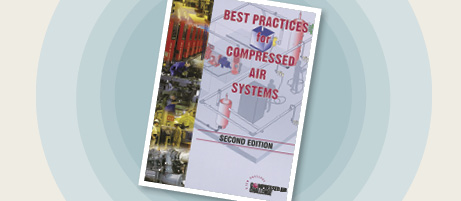Follow Best Practices: Guidance from the Experts
One of the most efficient and effective ways to work in the compressed air industry is to choose not to make your own mistakes while learning the hard way. The quickest way to achieve success is to emulate the best practices of past masters in the field. These experts often choose to leave a legacy to future tradespersons by writing guides and best practices for our benefit.
We are fortunate that two experienced compressed air experts, William Scales and David McCulloch, with combined experience of more than 90 years in the business, have written a classic guidebook, “Best Practices for Compressed Air Systems,” for the Compressed Air Challenge (CAC).
Purpose of the Manual
Compressed air is a very useful and valuable utility, but expensive to produce, which means it should be managed carefully. The Best Practices Manual (BPM) was developed to provide compressed air users with the tools they need to reduce the operating costs associated with the use of compressed air and to improve the reliability of the entire system. The BPM addresses many typical improvement opportunities, starting from where the air enters the compressor inlet filter and going all the way through to the final end uses, including hoses, quick couplers, air tools, cylinders, or other devices.
The measures recommended in the manual typically do the following:
- Reduce energy and repair costs
- Improve system reliability
- Increase productivity
- Reduce unscheduled downtime
The BPM suggests points to consider when analyzing existing systems or designing new ones. All parts of compressed air systems are discussed, including the air compressors, the auxiliary conditioning equipment, distribution system, and the end uses. The manual guides technical staff in determining how to use measurements to audit their own systems, how to calculate the cost of compressed air, and even how to interpret electric utility bills. Best-practice recommendations are given for the selection, installation, maintenance, and operation of all the equipment and components within the compressed air system.
Using the Manual
The Best Practices Manual is intended for anyone involved with any part of the complete compressed air system. The manual may be used as a reference for a specific problem or as a full text covering the complete system. References to other sources for further study are listed. Appendices provide useful tables, charts, graphs, and additional information that supplement the understanding and application of the main text.
Although individual components are addressed, the focus of the manual is always on the systems approach, realizing that the distribution system and the demand side of the system have a significant impact on the supply-side equipment operation of compressors, dryers, air receivers, and air-treatment equipment.
There is not always a single answer to what is the best solution to common problems; in many cases, alternatives are provided. Similarly, the selection of a particular type of compressor or dryer or distribution system in one plant may not be the best for a different plant; therefore, multiple solutions may be suggested.
In many industrial plants, the air compressor(s) will consume more energy than any other equipment. With proper application of the system approach, savings of 50% or more have been achieved. The BPM teaches you how to evaluate your own system by following simple steps or by knowing what questions to ask a professional service provider if one is retained to perform a walk-through or assessment of your system.
Improving the system and maintaining peak performance is an ongoing process and will require your continuous attention. The CAC, through its Best Practices Manual, is dedicated to assisting you in achieving the peak operating performance of your compressed air system. It is up to you to maintain that level using the information within the manual, from attending CAC training, and from other available resources.
Summary of Main Points
Some selected important key points from the BPM:
- Accurate measurements of system air consumption and electrical power (called creating a baseline) allow proper assessment and appreciation of the true cost of operation. This, in turn, can help in management and conservation of available resources.
- The system should be delivering air at the lowest practical pressure. Operating at an elevated system pressure increases the air consumption of end uses, the rate of leaks, and overall energy consumption.
- Only the number of compressors required to meet the demand at any given time should be in operation, and only one should be operated in a “trim” control mode (partial load).
- It is common to find a leakage rate of 20% to 30% in the compressed air system of an industrial plant. An aggressive and continuous program of leak detection and elimination can reduce consumption substantially.
- The cost of compressed air often is overlooked because of the convenience and ergonomic advantages it provides. Make sure that compressed air is the best alternative for any application. Not all applications are appropriate.
- Applications that do not require compressed air 100% of the time should have the supply shut off when not needed.
- Check the appropriateness and effectiveness of equipment used to control and deliver compressed air. Ensure proper storage receivers are used and that components are sized to limit pressure loss.
By Ron Marshall, Compressed Air Challenge
The Best Practices Manual is available at the www.compressedairchallenge.org. The manual is also included in CAC’s Fundamentals of Compressed Air seminar and webinar. For more information see CAC’s website.








